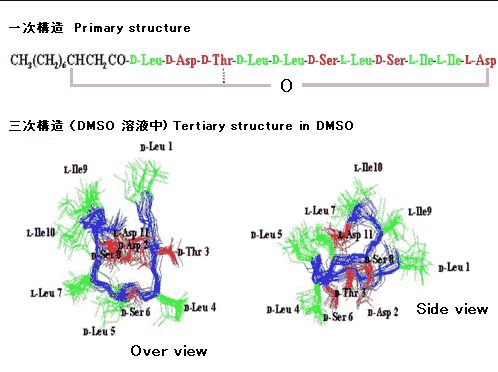Biosurfactants
Biosufactants are natural surface-active reagents mainly produced by microorganisms. Some oil field bacteria produce biosurfactants for effective uptake of hydrocarbons.
In 1993 we found a novel cyclic lipopeptide producing bacterium strain Pseudomonas sp. MIS38 [7]. Its product, namely Arthrofactin (Arf), is one of the most powerful biosurfactants ever reported. Arf is a macro lactone containing eleven amino acid residues linked to beta-hydroxyl fatty acid (C8-C12) group. We analyzed its structure-function relationships by chemical modification method and successfully determined the structure expressing the highest activity [34](Fig. 1). Arthrofactin synthetase gene cluster (arf) spanning 38.7 kb was cloned and characterized (Fig. 2). Three genes termed arfA, arfB, and arfC encode ArfA, ArfB, and Arf C, ArfC, containing two, four, and five functional modules , each module bears condensation, adenylation, and thiolation domains typical to non-ribosomal peptide synthetase (NRPS)[60](Fig. 3). The modules are usually colinear to the product peptide sequences. NRPS has attracted attention as a next generation synthesis tool for bioactive compounds [Rev6]. NRPS for Arf harbors unique dual condensation/epimerization domains whose activities are usually shared by two independent condensation and epimerization domains [72]. It was also found that strain MIS38 produced Arf in order to form highly structured biofilms. Forming biofilms is considered a general strategy of single cell microorganisms to survive in harsh environmental conditions. Please see “Biofilms” page.
Fig. 1
Fig. 2
Fig. 3



